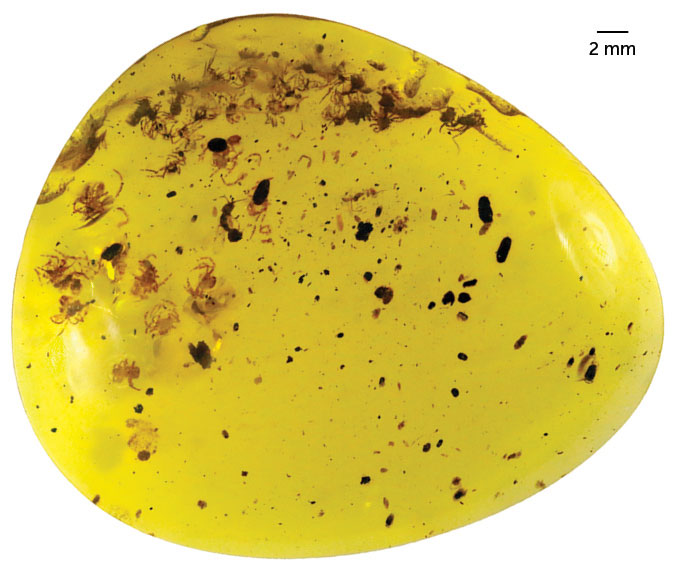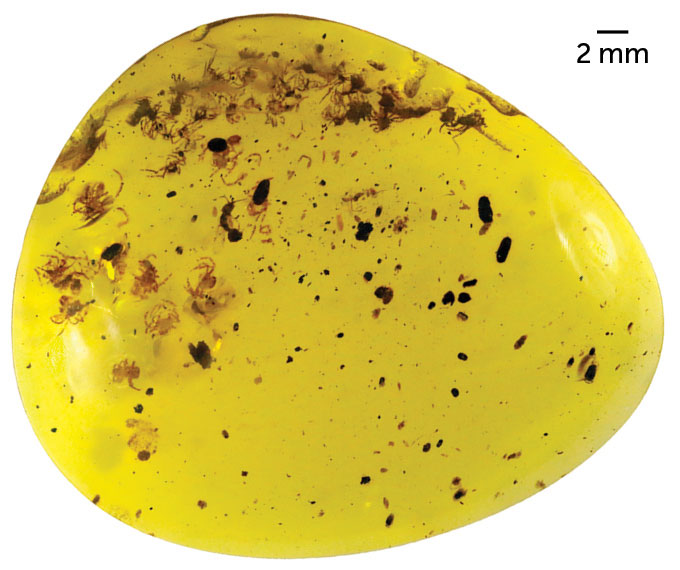Long before Tyrannosaurus rex walked the Earth, sap engulfed a spider guarding her egg sac.
Her corpse, preserved alongside her offspring in amber for 99 million years, is the oldest physical evidence for maternal care in spiders, says Paul Selden, an invertebrate paleontologist at the University of Kansas in Lawrence. This fossil is one of four showing that some ancient spiders guarded their egg sacs and may even have raised their young, Selden and his colleagues report September 15 in Proceedings of the Royal Society B.
Maternal care, such as guarding eggs, is common among modern spiders. Some species even go so far as nursing their young (SN: 10/29/18) or serving themselves up as their children’s first meal (SN: 4/21/15). Because maternal care is so widespread, researchers suspected that spiders developed this behavior long before the Cretaceous Period, which began around 145 million years ago.
But this “is the first time we’ve seen evidence for this behavior in fossils,” says Selden. The female spider and her unborn offspring belong to a now-extinct family of spiders called Lagonomegopidae, distinguished by their large, reflective eyes. She and her kin would probably have hunted in trees at night.
Along with guarding their eggs, female spiders may have stuck around after the eggs hatched. Three of the chunks of amber contain dozens of week-old spiders. Spiders are usually solitary creatures, so the presence of multiple spiderlings side-by-side suggests that they didn’t disperse after birth, choosing instead to stay alongside their mother.
 A pack of week-old spiders in amber suggests that these spiderlings didn’t disperse immediately after hatching.Xiangbo Guo
A pack of week-old spiders in amber suggests that these spiderlings didn’t disperse immediately after hatching.Xiangbo Guo  A pack of week-old spiders in amber suggests that these spiderlings didn’t disperse immediately after hatching.Xiangbo Guo
A pack of week-old spiders in amber suggests that these spiderlings didn’t disperse immediately after hatching.Xiangbo Guo
How long these spiders stuck around mom remains unclear. While the study “unequivocally” shows that these spiders were guarding their egg sacs during the mid-Cretaceous, “future researchers need to keep their eyes open for females with larger and older offspring,” says Linda Rayor, an entomologist at Cornell University who studies maternal care in spiders.
Researchers will have to look for further fossil evidence in existing museum and institutional collections. Some paleontologists are calling for a moratorium on publishing research on amber from Myanmar mined after 2017 over concerns of inhumane conditions in mines and worries that the sale of amber was funding militant groups, a situation further exacerbated by the military coup in 2021. The pieces of amber used in this study are part of a pre-existing collection at the Capital Normal University in Beijing and were mined over a decade ago.
That moratorium shouldn’t hinder future discoveries, Selden says. “There are already thousands of specimens — and more material than there are people available to study it.”

